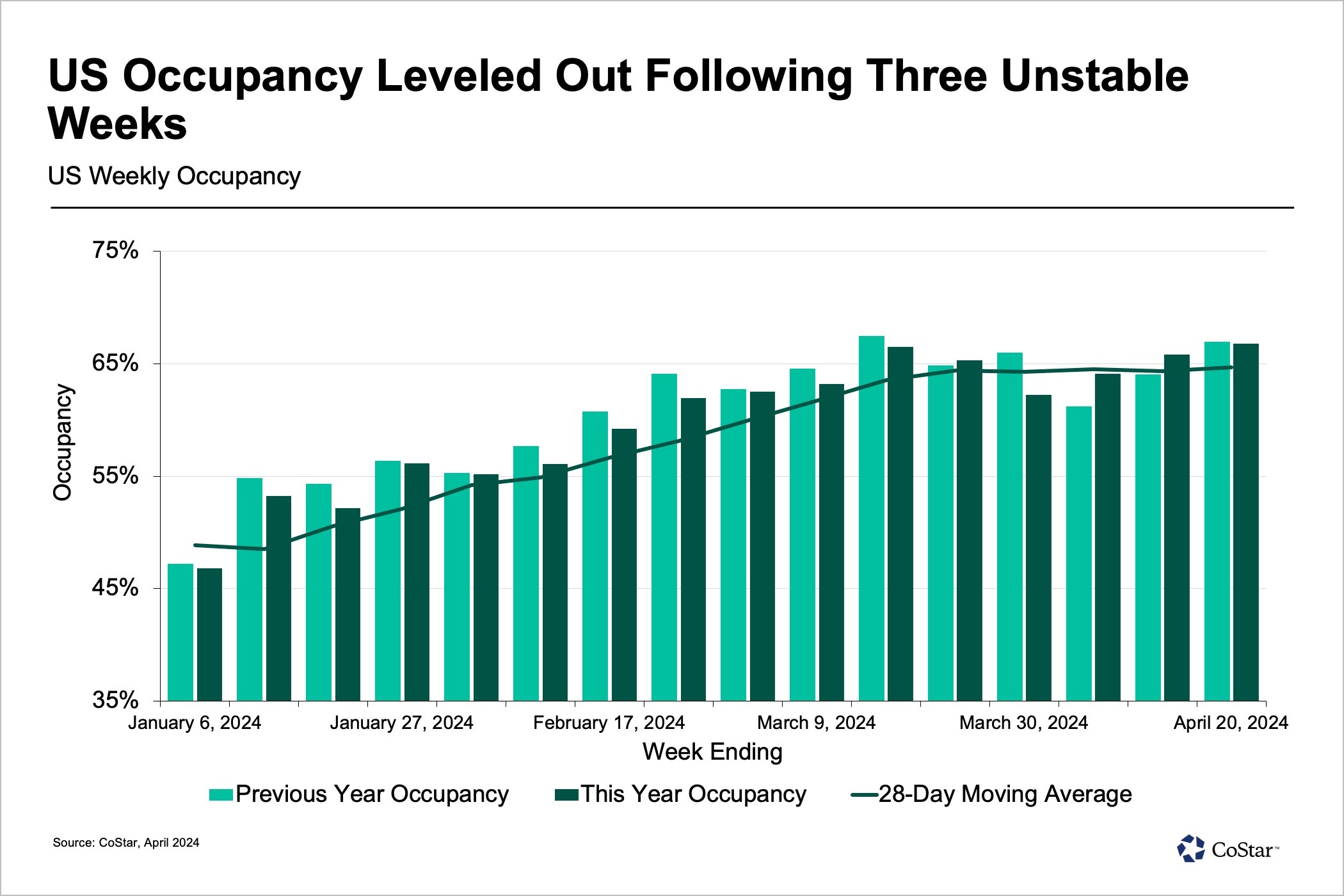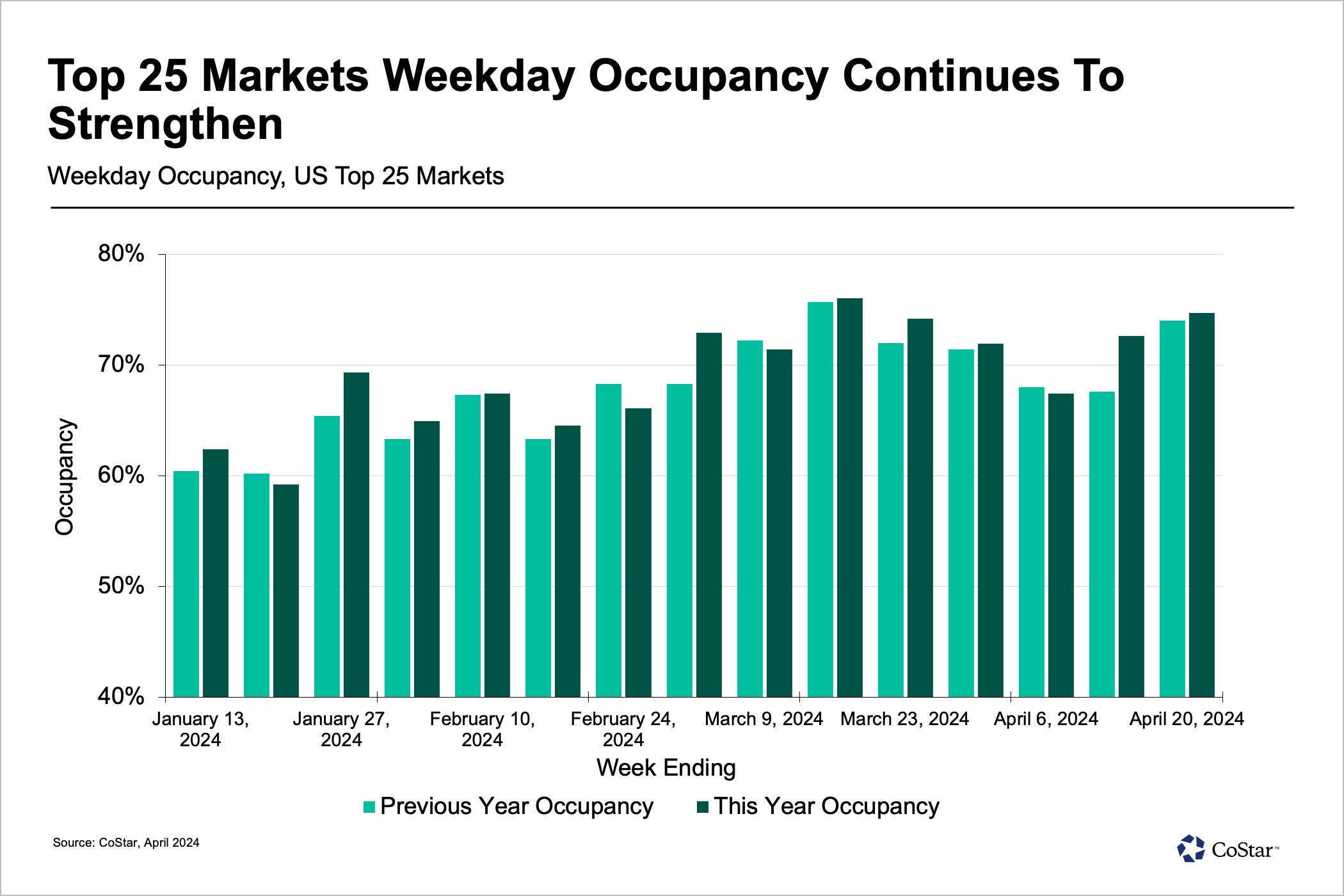Weekdays, not weekends, are driving U.S. hotel performance.
U.S. hotel performance stabilized following three volatile weeks affected by the total solar eclipse and Easter calendar shift. Normal patterns returned in the form of solid weekday and top 25 market performance, as well as strong group demand.
During the week of April 14-20, revenue per available room rose 1.2% year over year, driven entirely by average daily rate, which rose 1.5%. Occupancy reached 66.8% — the highest level seen in 2024 so far — but was essentially flat, dropping 0.2 percentage points year over year.

Weekdays Are Outperforming Weekends
U.S. hotels posted the best performance on weekdays from Monday through Wednesday, with all three days seeing approximately a 3% RevPAR gain, which was all from ADR. The shoulder period of Sunday and Thursday followed, with RevPAR increases of about 1.5% each day, which again were driven by ADR.
Friday and Saturday weekend nights, meanwhile, have been soft most of the year. This week, Saturday’s hotel RevPAR was down 2.0% and Friday’s RevPAR fell 0.2%.
Over the past 15 weeks — excluding the first week of the year due to the New Year’s Eve impact — average RevPAR change by day followed a steadily decreasing pattern from Monday, up 3.4%, to Saturday, down 1.2%. Sunday was the outlier, with an average RevPAR change of 2.6%.
This tidy pattern is possibly a reflection of travel patterns changing as extended leisure weekends decline due to waning pent-up demand. Extended business weekdays, however, have increased due to growing flexible work schedules.

How the Weekday, Weekend Shifts Affect the Top 25 Markets
The top 25 U.S. hotel markets increased RevPAR 1.6% via an ADR increase of 1% and an occupancy increase by 0.4 percentage points. The rest of the country saw a smaller RevPAR increase at 0.9%, which was lifted by a larger ADR increase of 1.7% but offset by an occupancy decline of 0.5 percentage points.
The day-of-week shifts described above for the total country generally followed when comparing the top 25 markets to the rest of the U.S., with a couple exceptions. Across the top 25 markets, the Saturday decline was more pronounced and the Thursday increase was greater, while Mondays were stronger for the non-top 25 markets and Thursdays were weaker.
Hotel Class Segments on Weekdays and Weekends
The shift to weekdays and away from weekends is having an impact on the performance of hotel classes. Strong weekdays tend to favor the higher-class hotels while strong weekends are more likely to lift lower-class hotels, and this was evident during the week of April 14-20.
Luxury class hotels recorded the largest weekly RevPAR increase at 3.5%, a combination of ADR increasing 1.1% and occupancy rising by 1.7 percentage points. Upscale hotels followed, with RevPAR increasing entirely on ADR growth of 1.4%. The upper upscale segment saw a modest RevPAR increase of 0.8%, with a 1.2% ADR gain offset by an occupancy decline of 0.3 percentage points. Upper midscale and midscale hotels saw little change, while the economy segment saw the largest RevPAR decline at 4.4%.
What stands out among all hotel classes is the slowing of ADR, which has remained below the rate of inflation in most weeks of 2024 and in 10 of the past 12 months.
Room Demand Bifurcation
For several months, there is clear bifurcation of the U.S. hotel industry in terms of demand change. Among branded hotels, upper-tier hotels — including luxury, upper upscale and upscale — in aggregate have not seen a monthly demand fall over the past 15 months, whereas demand for economy hotels has fallen in each month.
A similar pattern has also been seen in 2024 weekly results. This week, only the economy segment saw a demand decrease, but the decline — excluding the gains seen from the Easter shift — was the smallest of the year so far. There is some evidence of a moderation in the downward trend.
Market Performance
Philadelphia, St. Louis and Washington, D.C., posted double-digit, year-over-year RevPAR gains across all days. New York City and Phoenix also posted double-digit increases this week, with most of the growth coming from weekday and shoulder days.
Outside the top 25 markets, hotels in Augusta, Georgia, posted double-digit RevPAR, boosted by the conclusion of The Masters Tournament on Sunday. Also posting double-digit RevPAR weeks were Buffalo, New York, and Gatlinburg, Tennessee, which were lifted by robust weekend performance. Hotels in Indianapolis and Albany, New York, saw strong performance all week.
While the crowds were still significant over the two weekends of Coachella at more than 100,000 people, hotels in Palm Springs, California, saw all key performance indicators decrease year over year. Hotel RevPAR over Friday and Sunday of Coachella’s first weekend fell 15.7% compared to the same first weekend in 2023 via a 6.6-percentage-point decrease in occupancy and a 9% drop in ADR.
The first weekend of the 2024 event pushed ADR to $492 with occupancy reaching 83%. The second weekend, which normally sees lower hotel performance, was more affected, with RevPAR down 24%, occupancy down 9.9 percentage points and ADR down 14.2%. Disclaimer: Hotel performance on Coachella’s second weekend is an estimate, as data for Sunday, April 21, is preliminary; however, Friday and Saturday show similar results to the preliminary Sunday figure.
Group Demand Reaches Highest Level Since October 2023
Conventions and conferences are driving hotel performance, with group demand at U.S. luxury and upper upscale hotels reaching the highest level since the fall group season and just 3.8% below the post-pandemic all-time high.
Compared to 2019, group demand is 7.5% below the highest week recorded in that year. Group ADR is also strong, up 4.3% year over year. Over the past 16 weeks of 2024, weekly group ADR increased 12 times, with 11 weeks increasing above the rate of inflation.
The strong RevPAR gains seen this week in St. Louis and Philadelphia were driven in part by group demand, as these markets saw the largest group occupancy gains of the top 25 markets along with Dallas. St. Louis also posted double-digit ADR increases. Additional markets posting double-digit group ADR increases were Los Angeles, Detroit and Washington, D.C.

Expectations for the Rest of the Second Quarter and Start of Summer
Normalization remains the main theme of the U.S. hotel industry as it moves through the second quarter. The first 16 weeks of the year show RevPAR gains at a similar level as the last half of 2023. Looking ahead, gains in group, weekday and international inbound demand will offset some of the softness seen on the weekends as they slow.
Additionally, various indicators such as rising debt, delinquencies and inflation continue to point to slower leisure travel this year, especially in middle- to lower-income households. One theory is that we are seeing a shift from revenge to selective travel, with guests becoming more discriminating given the higher living costs. Onetime events such as graduations, weddings and concerts may carry more weight than the annual summer vacation.
Global Hotel Performance Strengthening
Global hotel occupancies outside of the U.S. continued to grow. The largest gain last week was Indonesia, up 9.1 percentage points year over year to 55%. Hotel ADR in Indonesia fell 2.3%, as all markets across the country showed a decline. This is attributable to the shifting nature of Ramadan, which was two weeks earlier this year.
Among the largest countries, Italy had the highest hotel occupancy at 78.5%; occupancy was up 3.4 percentage points, which can be attributed to the beginning of the international art event La Biennale di Venezia. ADR in Italy rose 22.4%, resulting in a 26.4% RevPAR gain. In Venice, where the event takes place, hotel ADR soared by 126%, with occupancy growing 10.2 percentage points to 82.1%. Hotels in the nearby Italian Northeast market equally benefited from the event, with occupancy up 5.6 percentage points and ADR increasing 11%.
Leisure travel also showed signs of blooming, as Sardinia, Italy, saw hotel occupancy grow 17.5 percentage points and ADR jumped 31.1%. However, market occupancy was still low at 44.2% given it’s early in the season. Spain — another key leisure country — grew hotel occupancy by 3.4 percentage points to 77%, with its largest increases coming from the Mediterranean Coast and Canary Islands, up 9.8 percentage points and 9 percentage points, respectively.

The United Kingdom was the only key country with a slight occupancy decline this week at 0.9 pecentage points, which is attributable to the shifting school holidays around Easter. As a result, RevPAR was flat, down just 0.2%. The U.K. still had the second-highest occupancy of any key country this week at 78%.
Outside of the U.S., the global hotel industry will see further strengthening with the 2024 Paris Olympics, rising international travel and Taylor Swift’s tour driving the gains. Outbound U.S. travelers, however, are expected to slow, but that is not evident just yet.
Isaac Collazo is vice president of analytics at STR. Chris Klauda is senior director of market insights at STR. William Anns is a research analyst at STR.
This article represents an interpretation of data collected by CoStar's hospitality analytics firm, STR. Please feel free to contact an editor with any questions or concerns. For more analysis of STR data, visit the data insights blog on STR.com.
